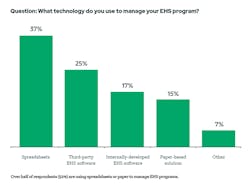Companies of all sizes—no matter what industry sector they’re involved in—tend to be challenged by the same business and workforce obstacles. Every company has to meet its budget numbers, every company is prone to adverse market conditions, every company faces the need to attract and retain workers, and every company wants to keep its workers safe from harm. The difference between high-performing companies and those who perform poorly is how they tackle those challenges.
A new “State of the Industry” study from EHS Today and KPA, a provider of EHS and workforce compliance solutions, reveals that the achievement of high performance in environment, health and safety (EHS) requires improved technology systems, executive leadership and processes that enable a strong safety culture. The study is based on a recent survey of more than 550 people who are actively involved in their company’s safety program, and it looks at whether companies are investing in EHS programs and software, as well as what the future holds for budgeting and growth.
What the study reveals is that companies that rely on EHS software are more effective at improving outcomes, while companies reporting an increase in absenteeism, injuries and safety violations tend to rely on older or little technology. And over half (52%) of respondents are using spreadsheets or paper to manage their EHS programs (see chart below).
“The challenge with manual spreadsheets or clipboards with paper is you can’t ensure you’re collecting the right information at the right time, every time,” explains Kathryn Carlson, KPA’s vice president of product management. “The other challenge, in our digital society, is that most people expect to have access to information online, from any device.”
The survey also confirms what many have long suspected: low-performing companies say that executive support for safety initiatives is harder to come by as compared to high-performing companies. What’s more, low-performing companies say that budget issues are also challenging or extremely challenging.
“Leadership support is perhaps the most critical factor in the success or failure of an EHS program,” Carlson observes. “And it’s not just about a CEO or EVP, but a leader who is willing to demonstrate ownership or sponsorship of the program. EHS programs might seem like an expense without a return on investment, but this report shows those companies investing in technology are outperforming their peers.”


